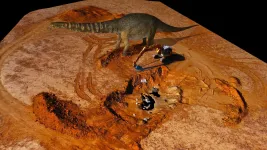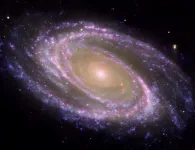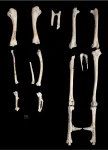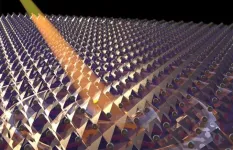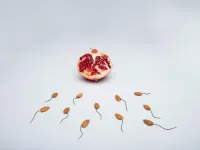Australotitan, "the southern titan", has been scientifically described and named by Queensland Museum and Eromanga Natural History Museum palaeontologists. It is estimated to have reached a height of 5-6.5 metres at the hip and 25- 30 metres in length and sits within the top 10-15 largest dinosaurs world-wide, representing Australia's entry into the largest species to have ever walked the Earth. The fossilised skeleton was originally nicknamed 'Cooper' after Cooper Creek, when first discovered in 2007 by the Eromanga Natural History Museum. It now represents the largest species of dinosaur ever found in Australia. The scientific publication marks a seventeen-year long culmination of the joint effort between Queensland Museum and Eromanga Natural History Museum palaeontologists, fossil preparators, geologists, and countless volunteers. "Australotitan adds to the growing list of uniquely Australian dinosaur species discovered in Outback Queensland, and just as importantly showcases a totally new area for dinosaur discovery in Australia," Dr Hocknull said.
"To make sure Australotitan was a different species, we needed to compare its bones to the bones of other species from Queensland and globally. This was a very long and painstaking task."
Dinosaur bones are enormous, heavy and fragile, and are kept in museums 100s-1000s of kilometres apart, making scientific study very difficult. For the first time, the team used new digital technology to 3-D scan each bone of Australotitan and compare them to the bones of its closest relatives. These scans will form part of the museum's digital collection that is powered by Project DIG, a partnership between Queensland Museum Network and BHP.
"The 3-D scans we created allowed me to carry around 1000s of kilos dinosaur bones in a 7kg laptop. Better yet, we can now share these scans and knowledge online with the world," Dr Hocknull said.
The study found that Australotitan was closely related to three other Australian sauropods that lived during the Cretaceous Period (92-96 million years ago).
"We compared the three species found to the north, near Winton, to our new Eromanga giant and it looks like Australia's largest dinosaurs were all part of one big happy family.
"We found that Australotitan was the largest in the family, followed by Wintonotitan with big hips and long legs, whilst the two smaller sauropods, Diamantinasaurus and Savannasaurus were shorter in stature and heavily-set." Dr Hocknull said along with the description of Australotitan, the study has also revealed a swathe of new discoveries in the area awaiting full scientific study.
"Over the last 17-years numerous dinosaur, skeletons have been found, including one with an almost complete tail. The discovery of a rock-shelf, almost 100 metres long, represents a sauropod pathway, where the dinosaurs walked along trampling mud and bones into the soft ground," Dr Hocknull said. "Discoveries like this are just the tip of the iceberg. Our ultimate goal is to find the evidence that tells the changing story of Queensland, hundreds of millions of years in the making. A grand story all scientists, museums and tourists can get behind."
Minister for Arts Leeanne Enoch said the exciting new discovery helps to cement Queensland as Australia's dinosaur capital.
"Discoveries like Australotitan tell the story of a time when dinosaurs roamed Queensland," Minister Enoch said.
"Queensland Museum experts have been on the ground, sharing their knowledge with regional museums and helping to preserve and better understand the diverse paleontological hi story of our state.
"These unique outback discoveries are supporting Queensland as we deliver our economic recovery plan creating local jobs in regional and cultural tourism." Robyn Mackenzie, General Manager of Eromanga Natural History Museum said it's an exciting culmination of a major amount of work.
"Finding Cooper has changed the course of our lives and led to the establishment of the Eromanga Natural History Museum," Ms Mackenzie said.
"Working with Queensland Museum to formally describe Cooper has helped put our little town of Eromanga in Quilpie Shire South West Qld on the map. Australotitan is just the start, we have many more discoveries awaiting full scientific study.
"It's amazing to think from the first bones discovered by our son, the first digs with the Queensland Museum, through to the development of a not-for-profit museum that runs annual dinosaur digs, all have helped us to get to this point, it's a real privilege."
Queensland Museum Network CEO Dr Jim Thompson said this represented the first dinosaur discovery in this corner of south-west Queensland.
"In the early 2000s Australia was at the beginning of a dinosaur-rush,with a number of significant new species of dinosaurs and megafauna being discovered in the past 20 years. Australia is one of the last frontiers for dinosaur discovery and Queensland is quickly cementing itself as the palaeo- capital of the nation - there is still plenty more to discover," Dr Thompson said.
"I am proud that Queensland Museum palaeontologists have been part of many of these amazing discoveries and are leaders in their fields."
The new paper was published recently in PeerJ - the Journal of Life and Environmental Sciences
INFORMATION:
Link to the Published Version of the article (quote this link in your story - the link will ONLY work after the embargo lifts): https://peerj.com/articles/11317/ your readers will be able to freely access this article at this URL.
Citation to the article: https://peerj.com/articles/11317/
Press Pack: https://www.dropbox.com/sh/yinoxajhh599ah6/AADjadszbaL9uxYbp2tdFvSma?dl=0
Media Enquiries:
media@qm.qld.gov.au
Christine Robertson, Senior Media Officer, 3153 4451/0417 741 710 Kylie Hay, Senior Media Officer, 3153 4450/0434 565 852
About Australotitan cooperensis Hocknull et al., 2021 ("Cooper" - Australia's largest dinosaur)
Name: Australotitan cooperensis
Pronounced: Australo - titan ; cooper - en - sis
Meaning: Southern Titan from the Cooper (Cooper Creek)
Found: West of Eromanga, South-west Queensland, Australia
Age: Approximately 92-96 million years ago. Cretaceous Period, Cenomanian - Turonian Epoch.
Size: Based on the prepared remains of Australotitan cooperensis, it's estimated that the species could reach 25-30 metres long and 5-6.5 metres high (ground to hip).
Type: Giant titanosaurian sauropod (long-necked, plant-eating sauropod)
Formation: Winton Formation, Eromanga Basin.
ABOUT SAUROPODS:
Sauropod dinosaurs were herbivores and had very long necks, long tails, small heads and four thick, pillar-like legs. They are known for their enormous size and includes some of the largest animals to ever have lived on land.
The name Sauropoda was coined by OC Marsh in 1878 and is derived from the Greek meaning 'Lizard Foot'
They are one of the most recognisable groups of dinosaurs in the world.
Fast facts about Australotitan:
Largest skeletal remains of a dinosaur ever to be discovered in Australia.
Based on skeletal measurements, Australotitan is within the top 10-15 largest dinosaurs world-wide.
Australotitan is a titanosaurian sauropod. Titanosaurians are one of the last remaining sauropod groups in the Cretaceous Period and also were the largest ever land -dwelling animals.
Fossils of Australotitan was found on a tributary of the famous inland river system, Cooper Creek in the Cooper/Eromanga Basin and this is where the nickname came from
Titanosaurians have been found across the globe, however, little is known of the Australian dinosaur species world.
Australotitan comes from the Winton Formation, one of the largest geological layers in Australia from the time of the dinosaurs.
Australotitan is closely related to other sauropod species found in the Winton Formation, Diamantinasaurus, Wintonotitan and Savannasaurus.
Determining the mass of Australotitan is very difficult. Scientists estimate it weighed between 23,000 - 74,000 kg, possibly as much as 67,000 kg.?
About:
PeerJ is an Open Access publisher of seven peer-reviewed journals covering biology, environmental sciences, computer sciences, and chemistry. With an emphasis on high-quality and efficient peer review, PeerJ's mission is to help the world efficiently publish its knowledge. All works published by PeerJ are Open Access and published using a Creative Commons license (CC-BY 4.0). PeerJ is based in San Diego, CA and the UK and can be accessed at peerj.com
PeerJ - the Journal of Life and Environmental Sciences is the peer-reviewed journal for Biology, Medicine and Environmental Sciences. PeerJ has recently added 15 areas in environmental science subject areas, including Natural Resource Management, Climate Change Biology, and Environmental Impacts.
peerj.com/environmental-sciences
Across its journals, PeerJ has an Editorial Board of over 2,000 respected academics, including 5 Nobel Laureates. PeerJ was the recipient of the 2013 ALPSP Award for Publishing Innovation. PeerJ Media Resources (including logos) can be found at: peerj.com/about/press
